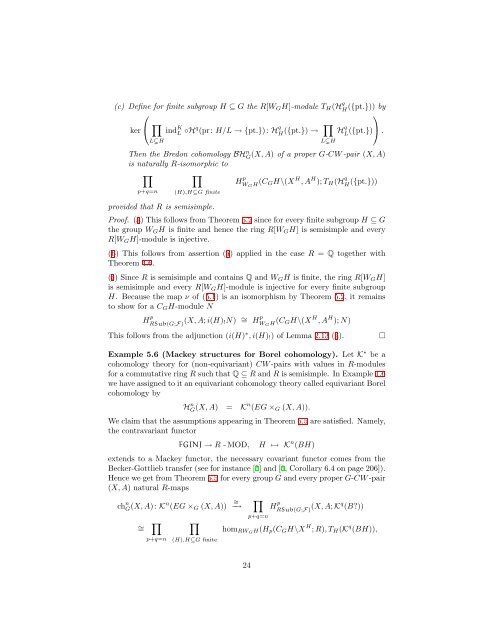Equivariant Cohomological Chern Characters
Equivariant Cohomological Chern Characters
Equivariant Cohomological Chern Characters
Create successful ePaper yourself
Turn your PDF publications into a flip-book with our unique Google optimized e-Paper software.
(c) Define for finite subgroup H ⊆ G the R[W G H]-module T H (H q H({pt.})) by⎛⎞ker ⎝ ∏ind K L ◦H q (pr: H/L → {pt.}): H q H ({pt.}) → ∏H q L ({pt.}) ⎠ .LHLHThen the Bredon cohomology BHG n (X, A) of a proper G-CW -pair (X, A)is naturally R-isomorphic to∏ ∏H p W G H (C GH\(X H , A H ); T H (H q H ({pt.}))p+q=n(H),H⊆G finiteprovided that R is semisimple.Proof. (a) This follows from Theorem 5.2 since for every finite subgroup H ⊆ Gthe group W G H is finite and hence the ring R[W G H] is semisimple and everyR[W G H]-module is injective.(b) This follows from assertion (a) applied in the case R = Q together withTheorem 4.6.(c) Since R is semisimple and contains Q and W G H is finite, the ring R[W G H]is semisimple and every R[W G H]-module is injective for every finite subgroupH. Because the map ν of (5.1) is an isomorphism by Theorem 5.2, it remainsto show for a C G H-module NH p RSub(G;F) (X, A; i(H) !N) ∼ = H p W G H (C GH\(X H , A H ); N)This follows from the adjunction (i(H) ∗ , i(H) ! ) of Lemma 2.13 (a).Example 5.6 (Mackey structures for Borel cohomology). Let K ∗ be acohomology theory for (non-equivariant) CW -pairs with values in R-modulesfor a commutative ring R such that Q ⊆ R and R is semisimple. In Example 1.6we have assigned to it an equivariant cohomology theory called equivariant Borelcohomology byH n G(X, A) = K n (EG × G (X, A)).We claim that the assumptions appearing in Theorem 5.5 are satisfied. Namely,the contravariant functorFGINJ → R - MOD,H ↦→ K n (BH)extends to a Mackey functor, the necessary covariant functor comes from theBecker-Gottlieb transfer (see for instance [5] and [6, Corollary 6.4 on page 206]).Hence we get from Theorem 5.5 for every group G and every proper G-CW -pair(X, A) natural R-mapsch n G(X, A): K n ∼ =(EG × G (X, A)) −→∏H p RSub(G;F) (X, A; Kq (B?))∼= ∏p+q=n∏(H),H⊆G finitep+q=nhom RWG H(H p (C G H\X H ; R), T H (K q (BH)),24
















